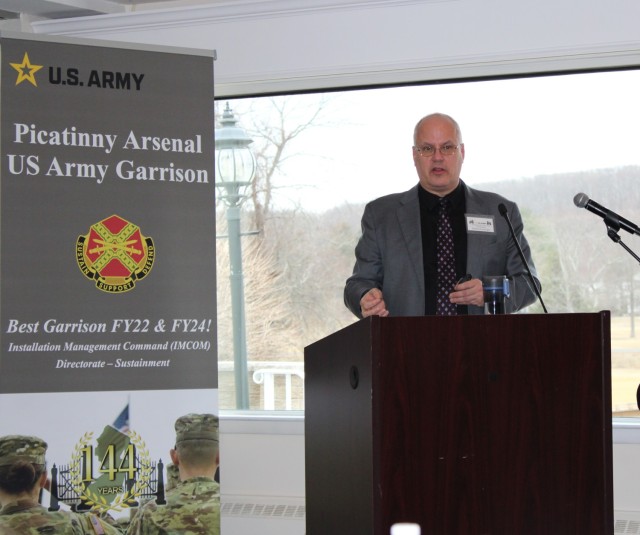
PICATINNY ARSENAL, N.J. - More than 40 participants representing the U.S. Army and multiple northern New Jersey municipalities convened during a Community Partners meeting at “The Club at Picatinny” facility on March 5.
Dave Leinberger, Army Community Partnerships chief, Office of Deputy Chief of Staff G-9 (Installations), Headquarters Department of the Army, arrived from the Pentagon to establish a dialogue between Picatinny Arsenal leaders and local elected officials that included, township mayors and members of the Picatinny Enhancement Coalition (PEC). The coalition is a 501(c)(6) non-profit corporation chartered to support Picatinny Arsenal and other New Jersey-based military installations. State Senator Anthony Bucco also attended.
Leinberger gave a briefing on the Army Community Partnership (ACP) Program, which is dedicated to assisting the entire Army enterprise and partners in identifying the appropriate partnership authority tool to execute mutually beneficial partnerships.
These partnerships are often created through intergovernmental support agreements (IGSA), which aim to produce a cost savings/avoidance and efficiencies for the Army and the surrounding communities while strengthening the relationships between the installation and outside partners.

“Collaboration with federal, state and local governments is crucial for sustaining Army priorities, readiness, reform and modernization,” Leinberger said.
Because Picatinny employees live in many of the represented communities, the purpose of the gathering was to describe how the installation’s mission supports the nation, and how those neighboring municipalities contribute to that success. The meeting also facilitated discussions that may result in mutual partnerships.
“We can’t do on-base, what we do, without working with our off-base partners,” Leinberger said.
“They are really good at running their communities, often times in larger scale than what we are doing on-base. My goal is to find a way to partner with them and find that mutual beneficial compromise.
“Picatinny has several small towns around it. Small towns are ideal partners. Those small towns have leaders who are hungry to do business with the Army and cut operating costs where possible. Picatinny is best suited for the IGSA process. This installation has a really healthy relationship with local leaders, and they want to engage.”
Leinberger also informed the guests that earlier this year, the Department of the Army announced Picatinny Arsenal as one of seven installations to be recognized as winners of the 2024 Army Community Partnership awards for the installation’s “outstanding partnership.” The 2024 award will officially be presented at the Army Community Partnership Recognition Ceremony this spring in the Pentagon Hall of Heroes.
Vince Matrisciano, a former Picatinny Arsenal employee and member of the PEC, helped spearhead Leinberger’s visit when he and other representatives from the coalition approached him in Washington D.C. in December.
“All the PEC members are volunteers who have a vested interest in Picatinny,” Matrisciano said.“ We are chartered to do things that Picatinny staff members cannot do, to include meeting with local, state, and federal elected officials to help propagate the message of how important Picatinny is to not only DoD and the Army but to the local community as well.”
After the meeting, Leinberger toured several facilities that fall under the scope of work performed by the installation’s Emergency Services, and Family, Morale, Welfare and Recreation Directorates.

Picatinny Arsenal is one of the top three employers in Morris County, New Jersey, according to the Morris County Office of Planning and Preservation, and supports the Army priorities of People, Readiness and Modernization. The installation’s capabilities are unique and vital to the nation, as the workforce leads the advancement of armament technologies and engineering innovation for the U.S. military.
The Picatinny Arsenal garrison supports mission partners that use unique laboratories, special facilities, and various performance measures to evaluate prototype designs, thus reducing development cycle time.

The garrison’s mission partners perform a broad scope of activities that include improvised explosive device (IED) defeat technologies, drones, precision-guided munitions, mortars, fire-control systems, small-arms weapon systems, howitzers, gunner protection armor, warheads, fuzes, and insensitive munitions, along with small, medium, and large caliber conventional ammunition.






Social Sharing